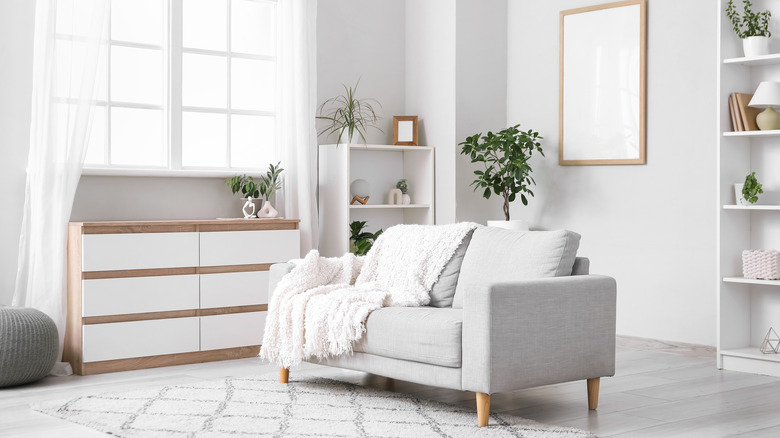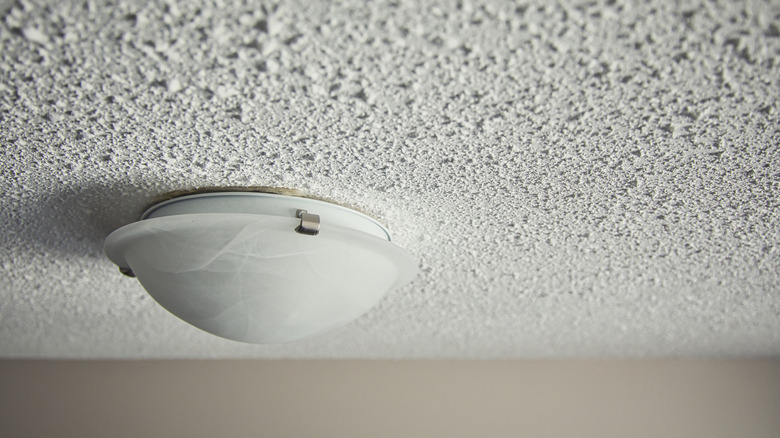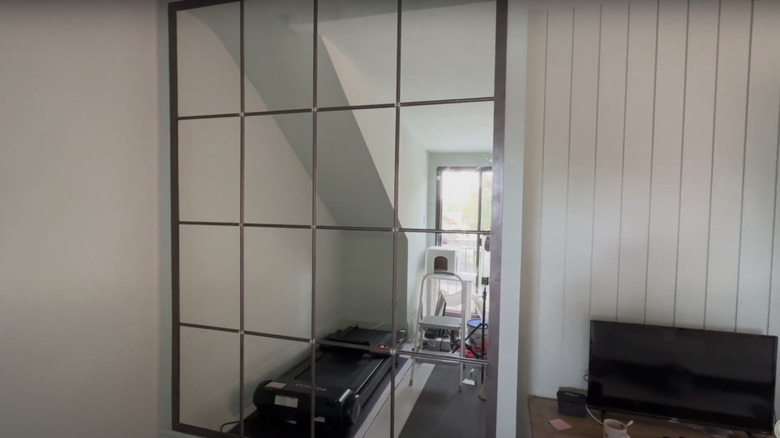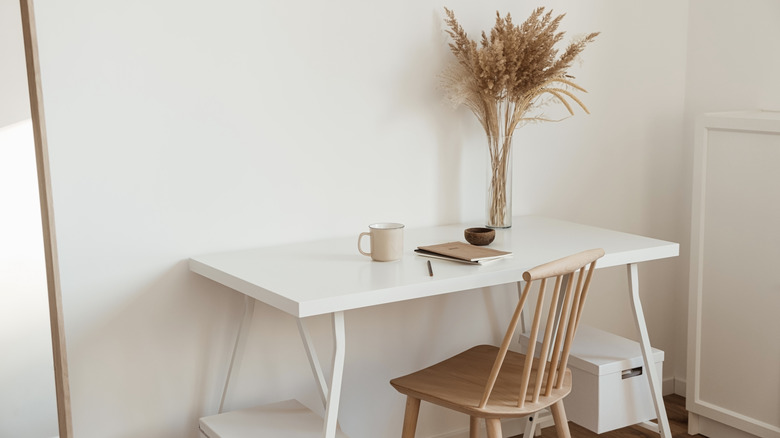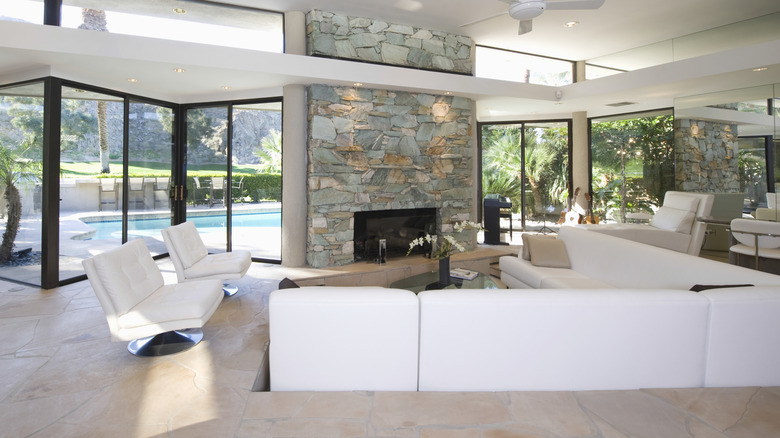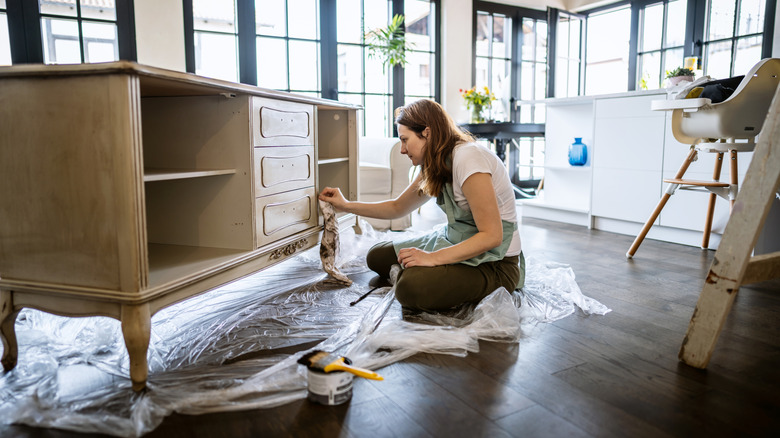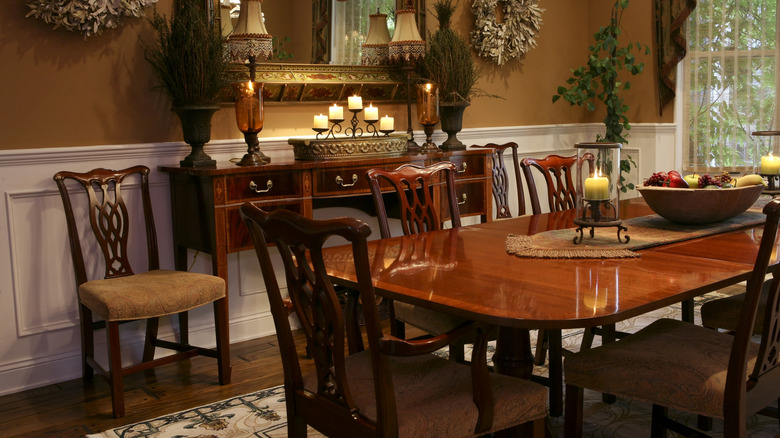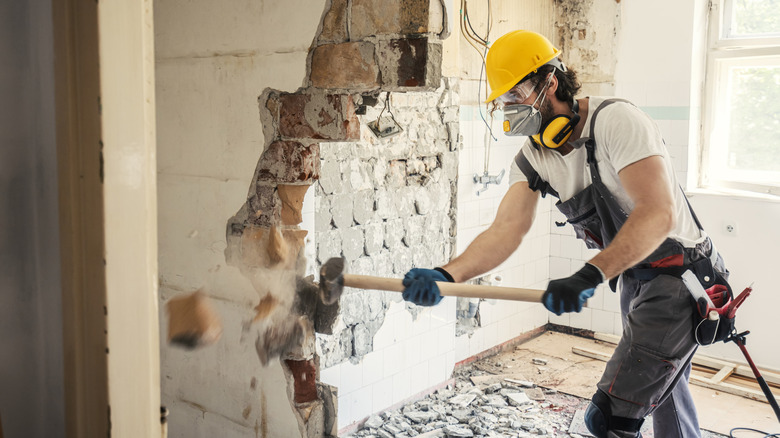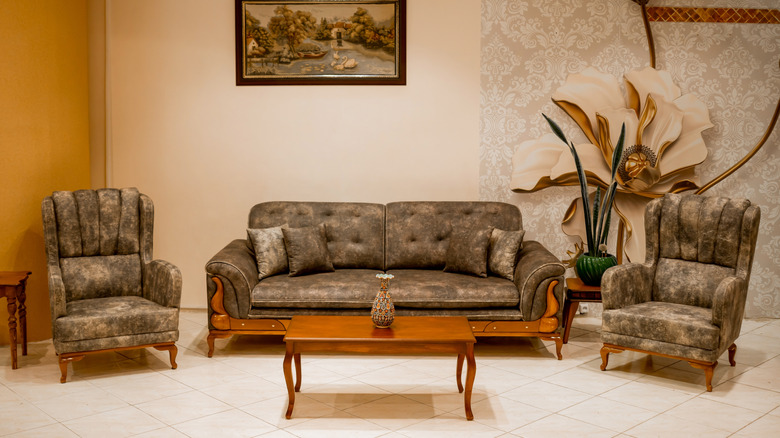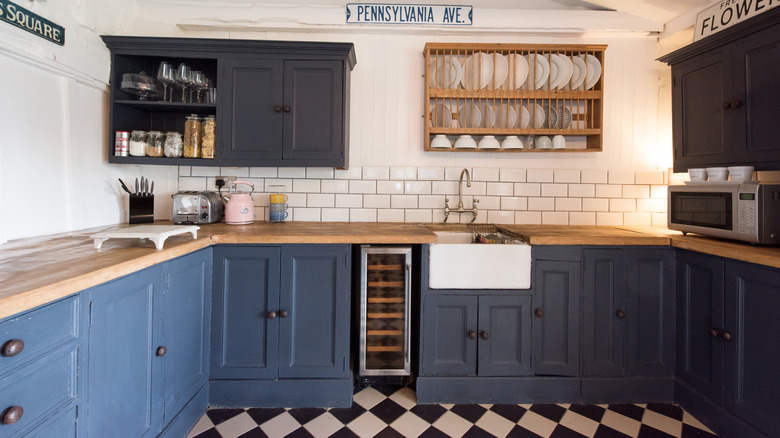10 Outdated Home Trends To Leave Behind, According To HGTV's Biggest Stars
We may receive a commission on purchases made from links.
Sure, there has been plenty of talk about the HGTV trends that no one wants anymore, like way too much shiplap and all-white kitchens. However, the channel's top design experts are looking beyond just the obvious when it comes to concepts to leave behind. Their insights go deeper than what's trending on Instagram or something that might feel dated in a few seasons, like the color of the year. Instead, they're calling out design choices that have been firmly stuck in the past for years, ones that can make your home feel like it's frozen in time. Think less "a little behind the times" and more "still living in the '80s or early 2000s."
These are the outdated elements that drag down your home's overall aesthetic without you even realizing it. They've outlived their moment and aren't making a comeback anytime soon — if ever. And while it might feel overwhelming to consider updating longstanding features, there's good news. Some of these stars also offer reasonable swaps for each idea. For every outdated trend they call out, they also suggest modern, practical alternatives that can bring your home up to speed without a full renovation, or any renovation at all in some cases. So, think of this as a guide to refreshing your space in ways that feel current, stylish, and (most importantly!) doable.
Dave and Jenny Marrs: Wave goodbye to Millennial Gray
Whether it was a response to the bold colors of the early aughts, or just a testament that Millennials prefer things plain, one thing is clear, Millennial Gray has had its day. At least, according to Dave and Jenny Marrs. "Grays are on their way out," Dave told Realtor.com when discussing outdated home trends. "That's true," Jenny agrees. "I think warmer and charming." And it's not just for paint hues, either. Designers are slowly leaning away from this outdated color trend in flooring choices, couches, and textiles like pillows, curtains, and even throw blankets.
Instead of the cool, muted vibe that gray tends to infuse into a space, modern choices skew towards livelier options. Look for colors that bring warmth and personality into a space. "I love decorating with green: muted greens and deep greens, beige greens and mossy greens. I use this color a lot," Jenny told Homes & Gardens. "As we all know, green is the color of nature, and I love bringing the outside in." Need to get inspired with specific shades? The Marrses have a large collection of ideas. For example, as part of their family farmhouse renovation, the Marrs chose a dark gray-green hue called Treron by Farrow & Ball for the main suite sitting area walls and used Benjamin Moore's Dark Olive in one of their children's bedrooms.
Erin and Ben Napier: Get rid of those popcorn ceilings
If you've ever wondered why homes have popcorn ceilings, you're not alone. Ben and Erin Napier are also not really fans of the textured style. "I hate all popcorn! Popcorn ceilings, popcorn, kettle corn," Ben joked in a Facebook video about the removal process. What started as a way for builders to cover any mishaps on ceilings in the post-war housing boom of the 1950s grew into a decoration phenomenon that lasted well into the 1980s. Once a modern, daring feature, popcorn ceilings are now more commonly associated with outdated housing and, unfortunately, asbestos.
Yet getting rid of popcorn ceilings might mean being left with a flat ceiling that feels too simple without texture. To avoid this, consider swapping your popcorn options for a more modern take, like a plastered finish or treated wood paneling. In the Season 6, Episode 5 of "Home Town," the Napiers do just this. "The ceiling can be this really light, kind of bleached wood look, and I think that becomes more feminine and it just gives us a little texture in the room," Erin said of the lime-washed wood paneling ceiling treatment. These options could even be installed over a popcorn ceiling. They can also add nice character to spaces that have never had textured ceilings at all.
Jonathan Scott: No more mirror walls
A large mirror on the wall can be super useful for daily life if you need to check your OOTD or make your room seem bigger and brighter. However, an entire wall of mirrors has been off-trend for years now. "Fully mirrored walls came and went," Jonathan Scott told Realtor.com. Instead of adding to a room, their inclusion really just makes your living room seem more like a home gym, and one that's stuck in the jazzercise era of the '80s at that. Even if broken up by shelving or panes that make the mirror appear to be in sections, if it's floor to ceiling and side to side, Scott thinks it's a home feature that is out of style.
Instead, use a large statement mirror. This has similar functionality as a mirror wall but feels fresh and modern instead of stuck in the past. For example, this Irregular Asymmetrical Wall Mirror is nearly three feet high, providing plenty of views while also being somewhat of a statement piece itself. If a head-to-toe view is important to you, the BEAUTYPEAK Full Length Mirror comes in a variety of large sizes and can be used anywhere you might want the look of a mirror wall.
Jeremiah Brent: Pampas grass just shouldn't exist
Once a staple of boho chic interiors, Jeremiah Brent is adamant that pampas grass doesn't have a place in anybody's living room, or the rest of their house, either. "Pampas grass as decor. Or just the fact that it exists," he told Dream Baby Press when asked about things he hates. The option got its start in the 1970s, as when dried out, its fluffy leaves have a sort of wispy, whimsical quality to some — but not Brent. He didn't expand whether he hates the plant's look alone, or because it's an invasive grass.
Whatever his reasons, he offers an alternative: Real plants. "I've always loved having a tree in our living room or in our home," he shared with fans on TikTok. Picking the right indoor tree for your home doesn't have to be difficult. In fact, the right placement for your indoor tree (somewhere with lots of light and space for it to grow) is more essential than the type you choose. That said, fiddle leaf fig trees are great for beginners and experts alike, while Boston ferns might require more intricate care. If you don't want to commit to something so big, consider swapping out pampas grass for a classic option that's easy and simple like a succulent garden.
The Property Brothers: Stay away from sunken living rooms
Sunken living rooms were once everywhere, but they are highly impractical for modern living. "It was such a hot trend for quite a long time, and then people realized everyone falls on their face." Jonathan Scott said on "Property Brothers: Forever Home." In Season 7, Episode 5, the brothers decide to level the flooring for $10,000 — a costly warning for anyone thinking of buying a home with one.
Yet there is some nostalgia for the design, and the brothers also understand that it did have a dedicated function. Sunken living rooms enclosed the space, making it feel cozier and separating it from the rest of the home. To achieve the same sort of unification, however, you don't need different levels. You just need a good area rug. To anchor a living room and create boundaries, much like a sunken floor would have, there are a few rules to follow. "The distance between an area rug and at least one wall should be between 12 and 18 inches so that flooring is visible," the brothers wrote in their book "Dream Home," per Oprah.com. "In oversized great rooms, you can increase that distance between wall and rug or have it completely free-floating in the center of the room if the space is big enough." This way, you can recreate the cozy, defined feel of a sunken living room, without the trip hazard or the renovation bill.
Erin Napier: Avoid painting wooden furniture
Erin Napier is a big fan of natural wood. While it's a modern trend to flip thrifted furniture, sometimes by painting it a bold, modern color, she doesn't think this is the best way to bring pieces forward from the past. "I hope we'll finally see people stepping away more from painted furniture and toward the warmth of natural and stained wood," she told PopSugar. "The organic movement in wood grain is art!"
If you love thrifting or if you're a Facebook Marketplace furniture shopper, Napier recommends looking for ways to enhance the natural finish on wooden pieces, instead of just covering them up. For example, using something like Minwax 63333 Clear Polycrylic Water-Based Protective Finish protects the natural wood from any further damage, but also gives it a nice shine. This way, you can really appreciate the natural beauty of the piece. For it to work, however, the wood needs to be clean, as well as stripped of any previous paints or stains. To achieve the smoothest surface for application, you'll also need to give the surface a good sanding first, using something like Romeda's Sanding Sponges.
Nate Berkus: Formal dining rooms don't always work for modern living
For many, the traditional formality of a closed-off dining room doesn't reflect how they eat or gather today. In a recent episode of "The Nate and Jeremiah Home Project," Nate Berkus proposed a solution that shows that a dining room can still exist. It just doesn't have to feel like a special-occasion-only space. "This vintage home is in what I would call good original condition," Berkus said, in Season 2, Episode 8. "But right away, I feel like it has a formality to it that seems outdated for a modern lifestyle." During the renovation, his team addressed that challenge by opening up the dining room to the kitchen and living room by greatly widening the doorways between the spaces. This resulted in a layout that was more usable for the way most people live today.
That said, formal dining rooms are having something of a comeback, especially among homeowners who love to host elegant dinners or simply enjoy the ritual of sitting down at a designated table for each meal. For them, a space that still feels quite separate might still make sense. But for the majority, Berkus's reimagined layout featuring a wider transitional space strikes a smart balance: preserving the function of a dining area, while making it feel accessible and ready for whatever the day (or dinner party) might bring.
Jenn Todryk: Closed floor plans don't always have to be opened up
Open floor plans have really come into their own in recent years, but older homes tend to have more structure. Because of this, you might feel tempted to tear down some walls to make things more modern, but you don't have to. "People are learning to love the house that they are in or maybe the one that they just got given the demands of the market," she told House Beautiful. "So, they are renovating these older homes and actually looking at it from a different perspective and liking the closed concept versus wishing they had the kind of open big box feel."
In some cases, keeping a home's original layout makes more sense, especially if you want to preserve its architectural character or avoid costly, large-scale renovations. You don't want to knock down or put up walls just because of what's currently trending. So, rather than gutting a space for the sake of openness, Todryk encourages looking at closed floor plans through a new lens. Consider how each room can function and the unique story a house can tell when its original structure is left intact. Plus, "you have more walls to decorate," she continued. This is true, as it's much easier to create the perfect gallery wall when you have more space to do so.
Joanna Gaines: Matchy-matchy interiors can hold you back
When decorating your home, you might be tempted to choose matching sets for everything, especially if you are buying new. However, Joanna Gaines warns against coordinating your interior too closely at the risk of feeling like a showroom rather than a real, lived-in space. "Early on, when I started, I always thought we have one or two styles," she told Domino. "As all of us are continually evolving, there are new things that we're loving; there are new things that we're telling our own story about. It's that mix that makes it feel more like home."
Instead of the same color palette, the same furniture style, and the same scale throughout your entire space, Gaines recommends focusing on overlap instead of just continuity. "It makes it feel more like you if your home has three or four different styles," she explained. Think of decorating your home like building a wardrobe. Unique outfits often come from mixing vintage pieces with modern staples. It's the same thing for your home. For example, instead of pairing a modern leather sofa with a matching sleek coffee table and side chairs from the same collection, try mixing in a vintage wood coffee table with some character and adding a pair of woven accent chairs, like the DuHome Linen Fabric Spindle Accent Chair, for texture.
Christina Haack: No more short tile backsplashes
In earlier seasons of "Flip or Flop," Christina Haack often relied on a combo of bold tile backsplashes paired with solid stone countertops. This coupling is a classic, as tile, especially in bright colors or unique shapes, can add plenty of personality to a kitchen. But on" Christina on the Coast," Haack tends to lean into sleeker, more unified design tricks like continuing the countertop material on the wall for a seamless stone backsplash. In Season 3, Episode 3, she explained, "Running the backsplash up the wall the way we did not only draws your eye up, making the room feel bigger, it also showcases the beautiful veining in the slab." This technique creates a high-end, cohesive look and eliminates grout lines, making the counter easier to clean.
If you're keen to try this look at home, ask your fabricator about using the same slab as your counter for the backsplash during your renovation. A bookmatched slab is a great countertop material where the veining mirrors itself, adding serious visual drama. If you're not ready to give up on tiles completely, you can still modernize the look by choosing zellige or large-format tiles and running them all the way up to the upper cabinets, or even the ceiling, for a more contemporary twist.

